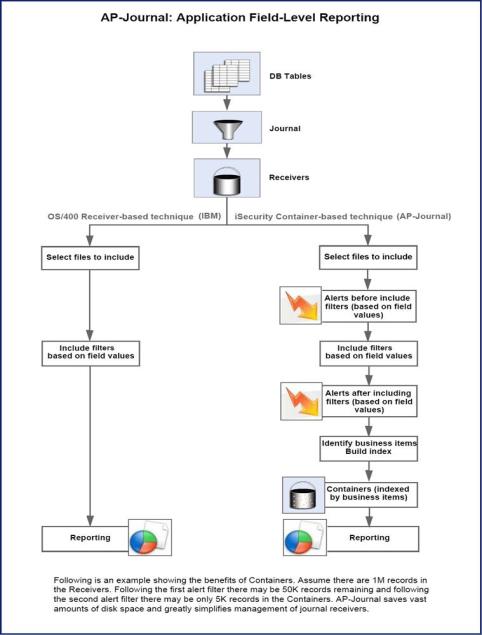Introducing AP-Journal
Overview
IBM i applications are based upon databases which include multiple tables. Each of these tables includes items of information that are used by one or more sub-applications. Any changes made to tables are logged by a process known as journaling. During a journal operation, changed information from a table is sent to a journal receiver. The journal receiver usually includes journaled information as well as journal meta-data that includes, for example, the name of the user who preformed the change, the name of the changed file, the date and time of change, the data image before and after the change, and so on.
Another way of looking at this is that IBM i user applications are usually based upon sub-applications appropriate for different groups of users. The various sub-applications many times use different data structures and sometimes one item of information can be represented in different ways in different tables. For example, the names of the fields that represent an account number, indeed even the length or data format of these fields and their location can differ from one table to another.
Let’s assume that a hospital uses one application to keep track of surgical proceedings executed by its staff, a second application to keep track of the prescriptions written by its staff and a third application to keep track of the patients being examined by its staff. The information relating to each application is stored in a different table, and different journal receivers store journaled information generated by the different applications.
Therefore, if a manager wishes to determine the activities of a certain staff member on a certain day (participated in a surgical procedure, dispensed prescriptions and examined a number of patients), the manager will have to manually combine information from different applications.
The AP-Journal Solution
AP-Journal automatically manages database changes by documenting and reporting exceptions made to the database journal. This cutting-edge security solution provides expert field-tracking and monitoring. AP-Journal is a valuable tool for Sarbanes-Oxley compliance and other auditing regulations.
Until now, database management has lacked the proper tools to monitor data modification down to the field level. This product offers a streamlined, easy-to-use solution. With AP-Journal, every field is tracked and monitored so that a trigger may be initiated if, for example, the amount of a bank loan has been modified by more than 20%. AP-Journal also provides tools and analysis capabilities to compare the changed data values and results with the previous data.
How AP-Journal Works
AP-Journal generates a control data structure representing multiple items of information that were journaled, from a group of tables to a group of journal receivers. AP-Journal’s journal data structure easily associates between different table representations for any particular item of information. AP-Journal also receives requests to retrieve journaled information items as necessary.
AP-Journal is fed by the IBM receiver, therefore it is enough to install AP-Journal in the machine where the receiver is located.
There is one point that has to be considered, an image of the running application database has to be defined in the remote system, in order to be able to retrieve into the application the file/field names. That image can be of course, empty files. Once this is done, AP-Journal can retrieve the information from the remote journal receiver that is located "locally".
Figure 1 compares the direct, IBM, approach to reporting on data base changes recorded in journal receivers with AP-Journal's container-based approach.
In comparison with using journal receivers, AP-Journal:
- saves disk space
- simplifies management of journal receivers
- reduces I/O and CPU time when retrieving data
- provides real-time e-mail or message alerts based upon changes to field values

Native IBM i (OS/400) Text Based User Interface
AP-Journal's reports specify not only the changes in data but also who made the changes, at what time, from which application, and more. Journaled data from several files can be cross-referenced by referral to joint information in all relevant files; that is, fields from different files can be identified as containing the same logical information (item number, loan ID, patient identifier, and so on). With this feature it is possible to obtain the history of a transaction by referring to the same ID across many files. Information accumulated over many years can be accessed in near real time mode. Data retrieval is simple and is defined in accordance with user needs. AP-Journal provides users more control than ever before over the flow of information within the organization.
AP-Journal is a valuable addition in industries such as finance, health-care, commerce, insurance, military, and others. As part of Raz-Lee’s iSecurity suite, AP-Journal offers you top functionality, ease-of-use, and tomorrow’s technology today.
AP-Journal is designed to be a user-friendly product. The user interface follows standard IBM i CUA conventions. All product features are available via the menus, so you are never required to memorize arcane commands.
Many features are also accessible via the command line, for the convenience of experienced users.
Regulation Compliance
AP-Journal's reports specify the changes in data but also who made the changes, at what time, from which application, and more. With this feature it is possible to obtain the history of a transaction by referring to the same ID across many files. Information accumulated over the years can be accessed in near real time mode.
